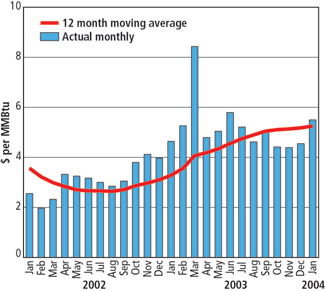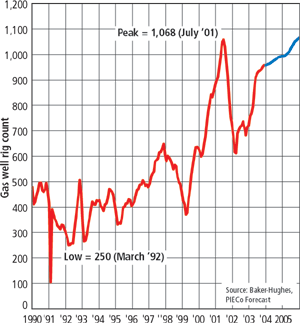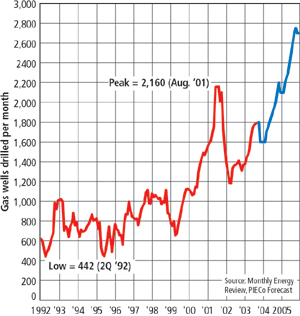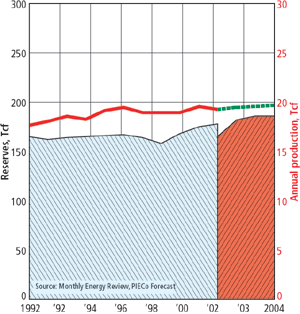OUTLOOK 2004
Natural Gas
Teetering
Prices remain on an upward track, while drilling, production and reserves are up. What could possibly go wrong?
Leonard Parent, Contributing Editor
High-flying volatility is a nemesis to planning ahead for the long haul. Teetering is not a good game plan. A lot will depend on the strength of the economic recovery and the Federal Energy Regulatory Commission's (FERC's) ability to keep the players from gaming the system. The outlook in 2004 is for wellhead prices to average close to $5.00/MMBtu.
We're on a roll with well drilling and reserve additions, if the addition numbers are accurate. But if we are to match supply with projected demand for the rest of this decade, we'd best be getting on with the program. Drilling is up and is likely to stay up as efforts are being made to ease some restrictions that have plagued the business. Look for a possible record year in drilling in 2004. On the flip side is the notion that there is a dearth of attractive prospects.
PRICES: RIDING THE WAVE
If Fig. 1 is any indication, gas prices are riding a wave-like, peak/valley pattern with an overall upward trend. The average price in 2002 was $3.11 (based on price data into the interstate pipelines), which was followed by an average of $5.18 for 2003. Absent the March peak, the 2003 average would probably have been about $4.80. The outlook for 2004 is for another wave, likely making a similar brief, early peak. The 2004 average, without the lift from an expected peak, will likely average near $5.00.
 |
Fig. 1. Monthly prices with 12-month moving average.
|
|
The price drivers are weather and storage, not necessarily working in tandem as used by the players on NYMEX. For example, fears of a summertime storage shortfall lifted prices unseasonably high last year, simply because the players made it happen. The run-up was followed by noticeable softening in the fall, when the shortfall fears disappeared, contrary to normal weather-related expectations.
This brings us to price volatility. Price control is in the hands of the NYMEX players. Daily prices in the pit often fluctuate by 10% or more in a day when the players perceive that weather forecasts will drive demand, or that storage fill/withdrawal rates do not fit expectations. Volatility may be great for traders, but not necessarily for buyers and sellers.
DRILLING
Well, something of a boom is on. We haven't yet matched the July 2001 peak of 1,068 gas-drilling rigs (Fig. 2), but we're gaining on it. More significant is that the downturn didn't take us back to the 400 mark. Rather, the turnaround began above 600 and is now nudging 1,000. Certainly, sustained higher prices are having a salutary influence on gas well drilling. Leading-edge operators are well tuned to gas-supply nuances and have seen price volatility. Reasonably assured that they are not likely to retreat to 2002 lows, the projected price regime can provide the stimulus for lifting, or at least maintaining, the rig count at where it is now.
 |
Fig. 2. Rigs drilling for gas in US with forecast (in blue).
|
|
A downside opinion by some holds that good prospects are hard to come by. The implication is that any price downturn will be followed by a comparable drilling downturn.
Close to 21,000 gas wells were drilled in 2003, down from a record 22,000 drilled in 2001, but better than in 2002. The outlook for 2004's drilling is a continuation of the upward trend, as supply is perceived getting tighter with prices staying up. The strong rig count, if maintained, could result in a new record for gas wells drilled, Fig. 3.
 |
Fig. 3. Number of gas wells drilled with forecast (in blue).
|
|
Much of the action has been in connection with coalbed methane (CBM) reserves, as they are a low-cost, low-risk operation. CBM wells are individually poor producers, but if you put enough of them together, it is possible to build a substantial flow rate.
RESERVE ADDITIONS
Reserve additions in the Gulf of Mexico offshore have not kept pace with production.
Table 1 data, taken from the DOE Annual Reserves Report, lists Lower 48 proved dry gas reserves to be 178.5 Tcf at year-end 2002 (Fig. 4); that's up by about 3.8 Tcf from 2001, which was up by 6.5 Tcf from 2000. At the rate we are going, year-end 2003 reserves should be well above the 180 Tcf mark, the highest level since the mid-'80s.
| |
Table 1. Lower-48 Gas Reserves at Year-End 2002 |
|
| |
Area |
Reserves
Tcf |
Year/Year
Change
Tcf |
Produc-
tion
Tcf |
R/P
Ratio |
|
|
|
|
| |
Gulf of Mexico |
24.7 |
–1.8 |
4.4 |
5.6 |
|
| |
Texas – East |
27.2 |
–0.2 |
3.4 |
8 |
|
| |
Texas – West |
17.1 |
0.9 |
1.6 |
10.7 |
|
| |
Wyoming |
20.5 |
2.1 |
1.4 |
14.6 |
|
| |
New Mexico |
17.3 |
–0.1 |
1.5 |
11.5 |
|
| |
Oklahoma |
14.9 |
1.3 |
1.5 |
9.9 |
|
| |
Louisiana |
9.0 |
–0.8 |
1.3 |
6.9 |
|
| |
All other (16 states) |
47.8 |
2.4 |
3.8 |
12.6 |
|
|
|
|
| |
Total |
178.5 |
3.8 |
18.9 |
9.4 |
|
| |
Source: US Energy Information Administration |
|
|
 |
Fig. 4. US dry gas reserves (blue) and production (red line). Values after 2002 are forecast.
|
|
It is worth noting that not all of the prime gas prone areas came out ahead. The most significant loser in 2002 – not so much the number, just that it's down – is the Gulf of Mexico, down by 1.8 Tcf after production. Wyoming, which is heavily into coalbed methane development, registered the biggest reserve additions gain for a single state, 2.1 Tcf. Louisiana reserve additions were also down, a drop of 0.8 Tcf. This is not good news for those markets that depend heavily on Gulf Coast gas. The deliverability issue is reflected by the R/P ratios in Table 1. The Gulf of Mexico R/P is an indication of high deliverability and, at the same time, of the need to maintain adequate reserve development in the Gulf to sustain high deliverability. The current downward trend in offshore drilling will have to be turned around soon. A footnote is in order here. If, as has recently surfaced, reserve additions have been exaggerated, we may be in for a downsizing.
PRODUCTION
According to DOE, early estimates of production show about a 2% increase in 2003, helping to offset reduced imports from Canada. Whatever the case, it was enough to keep up with 2.6% less demand from the previous year. However, there is modest optimism that the economy will improve enough to lift demand about 1% or so and a little more yet in 2005, all made possible by increasing gas-well completions.
According to the Natural Gas Supply Association (NGSA), some offshore Gulf of Mexico reserves are being depleted at rates approaching 50% during the first year onstream. That puts pipeline operators in a difficult position, building pipelines and expensive deepwater gathering facilities for short-lived fields. This observation is borne out by noting that the number of rigs drilling in the Gulf of Mexico is flat to down.
The Gulf of Mexico is the US' most prolific source of supply. Given the tightened security situation and new rules applicable to offshore activity, the outlook for higher levels of deepwater drilling is not very promising.
ALASKA
North Slope reserves, about 16 Tcf, dropped off the radar screens years ago due to the belief that the cost of building pipeline(s) from the North Slope to the Lower 48 were much too expensive. Since then, the economics still haven't improved all that much, but there seems to be a willingness on the part of the government to give financial support to make an Alaskan pipeline happen. The current thinking is that we could see work in progress before 2010. Assuming that it finally happens, we're looking at 2 – 3 Bcfd coming to the Lower 48 from the North Slope and McKenzie Delta. That is equivalent to about 4 – 5% of our current average daily demand, and a commitment of 15 – 20 Tcf to our reserve base.
Sometimes we tend to forget that LNG exports to Japan just keeping rolling along at about 60 plus Bcf per year. Not much change is expected there.
COALBED METHANE
Coalbed methane is getting more attention, Table 2. The majority of CBM reserves are in Rocky Mountain states, apart from about 7% in the Black Warrior basin of Alabama. The rate of CBM reserve additions in recent years has averaged better than 5% per year, quite a bit greater rate than for reserves from conventional resources. The outlook is for CBM reserves to continue to increase at that rate for the foreseeable future. Development of take-away pipelines will help boost production above the current rate of about 8 – 9% of US production. CBM accounts for about 10% of US gas reserves.
| |
Table 2. Coalbed Methane Reserves and Production |
|
|
|
Reserves |
Production |
|
| |
|
|
|
1990 |
5,087 |
196 |
|
|
1995 |
10,499 |
956 |
|
|
2000 |
15,708 |
1,379 |
|
|
|
|
|
2002 |
18,491 |
1,614 |
|
|
|
|
|
2005E |
21,500 |
1,900 |
|
|
Source: EIA |
|
|
IMPORTS
Imports from the Western Canada Sedimentary basin and from Nova Scotia have not lived up to expectations. Drilling slipped a little during 2003, but better times are ahead as Canadian companies get into CBM development and WCS basin activity picks up, responding to higher prices. LNG has become the darling of the industry as more and more project announcements make the headlines, but it will take a while for the projects to deliver gas into the system. Look for LNG deliveries to eventually ramp up to about 9 Bcfd of the gas supply mix, equivalent to nearly 15% of average daily supply, but because of tightened coastal security, there may well be delays in getting arrangements made for terminals.
DEMAND
A recovering economy didn't happen in 2003, but we have high hopes for 2004. We are looking at demand of a little over 22 Tcf, up about 1.2% and a little more in 2005, maybe up another 1.8%. It's hard to believe that we are delivering about the same amount of gas today as we were 30 years ago during the oil crisis of 1973.
The conventional wisdom holds that the decline in consumption during 2003 was as a result of high gas prices discouraging demand in industrial and electric power generation, a phenomenon sometimes known as demand destruction. A lot of the expected gain in 2004 is dependent on economic recovery, which for the moment looks promising, but we've been there before.
A long-term reality check is in order. Earlier pronouncements held that gas demand will pass the 30 Tcf mark by 2015. With what is happening in the US and around the world, we can let that forecast go by the boards for now. Spending money in these trying times for power plant upgrades is a luxury not everyone can afford. One fallback position is to rethink the option of refurbishing old plants. Another is to step up the construction of distributed generation projects, spreading the capital outlay amongst a broader group of investors.
There could well be fewer of the higher-efficiency, combined-cycle gas turbine generating stations coming on line over the next few years than previously expected. The issue cuts both ways in terms of gas consumption; refurbishing old gas using facilities is less efficient consumption, i.e., more gas used, but refurbishing old coal-fired steam plants or extending the life of nuclear plants means a loss of market for gas, period. Players caught in a capital squeeze will do what they have to do. And as it stands right now, environmental regulations are being relaxed, encouraging operators to hold off new gas-fired capacity, which in turn could lead to a shrinking of the near-term prospects for electric generation gas consumption.
STORAGE
Last year was a hard year for storage, but we got by again. At year end 2003, EIA reported that the working storage balance was a little ahead of the curve. Absent extended severe weather in January and February, the level of gas in storage will likely be sufficient to meet the call for withdrawals. New storage projects will be coming onstream, and if they fill as expected, concerns about withdrawal capacity should lessen.
PIPELINES
Few big projects are on tap, mostly debottlenecking. We also know that there's not a lot of major projects that have to be done right away. Given the capital crunch and environmental restrictions, we can expect major projects to be deferred as long as possible.
SECURITY
Additions and revisions to the gas industry infrastructure impact the industry's risk profile. It is not something that operators enjoy talking about. Security is a work in progress. The players can spend money until it's gone and all the while not have done much for security. Solutions can turn on capacity additions and innovative repair and recovery systems. Many years ago, during the cold war, a lot of effort went into developing pipeline interconnects all over the country to cope with the possibility of disruptions. As it turns out, many of these interconnects have enabled the players to move gas across the interstate network with remarkable ease.
CANADA
Annual gas production is sticking close to 6 Tcf. Exports from Canada to the US in 2003 are estimated to have edged over the 4 Tcf mark and the outlook is for a modest build, as coalbed methane in Alberta comes online and as Sable Island exploration continues. Sable Island gas primarily serves markets in the Northeast US.
Exports from the US to Canada are up and are likely to grow, representing utilization of US pipeline capacity to deliver gas from Western Canada into Eastern Canada markets to a point where gas from offshore eastern Canada is competitive. All told, exports to the US account for about two-thirds of annual production.
Drilling was down in 2003, probably tied to the low prices available to producers in the WCS basin – not a good sign. Expert opinion holds that drilling has to come up with the equivalent of 20% of current production each and every year – a tall order.
According to the Canadian Gas Potential Committee, the WCS basin continues to supply the majority of gas in Canada, with a resource potential estimated to be about 142 Tcf. All told, including Nova Scotia and the Northwest Territory, Canada's “nominal” remaining marketable gas reserves add up to about 190 Tcf. Going a step further to include reserves in remote frontier areas, the total rises to about 233 Tcf. This does not include unconventional gas resources, which are substantial. However, development of these resources will require extensive capital expenditures and drilling programs, something not likely to occur in the foreseeable future absent significant technological breakthroughs.
MEXICO
Exports to Mexico are on the rise, on the order of 300 Bcf in 2003 through 11 import points from California (3), Arizona (2) and Texas (6). Electric generation in northern Mexico is the primary reason for the increase. Exports to the US have dwindled to zero and will likely stay that way for the time being.
Mexico is relatively rich in established gas reserves. Most are located in the Burgos basin in northeast Mexico. Major political issues must be dealt with before achieving a much needed acceleration of gas production.
THE LONG LOOK
There's a lot of gas in the US and elsewhere. It is agreed that demand for gas will grow and that production from domestic reserves will be key. But it's going to take more than domestic production to satisfy expected demand in the years to come. Imports from Canada and gas from Alaska will be needed to cope with US demand growth. As LNG projects are realized, they will be a vital supplement to US gas supply. We are teetering on the knife edge of a supply/demand balance, where supply is expressed in terms of deliverability. It's nice to add reserves as the US has been doing. It's even nicer to add deliverability and reduce price volatility. What it boils down to is a recognition that the US needs to utilize its resources and technology in a timely manner. The more the US teeters on the brink, the more likely it'll slip and fall.
Natural gas is a likeable fuel, but if the price gets too high, users will find ways to get along without using natural gas. Accordingly, this projection is constructed on the premise of higher prices in the months and years ahead. Teetering is not an acceptable solution.
BEYOND THE HORIZON
Research is picking up speed on hydrates, and there has been more than academic interest by oil and gas producers. All it takes is time and money. What seems to be happening as research people get to the edge and acquire better tools to evaluate opportunities, we move beyond the academic fringe into the realities of opportunities. It appears like that is where we are. According to the EIA Natural Gas Hydrates Update, federal funding of natural gas hydrates research in fiscal year 2002 reached the authorized level of $7.7 million, more than that was actually committed via supplementation with other research funds available to DOE and several other federal agencies.
The first intentional production of methane from a gas hydrate deposit occurred in March 2002, in the permafrost of Canada's McKenzie River Delta. Gas from hydrates remains unproven as a resource, but the interest is real. The Fourth International Conference on Gas Hydrates was held in Yokohama last May. There were 290 participants, including 153 from other countries. For more information on this, see the report on page 13 of January's World Oil.
SUMMARY
Most of us agree that deregulation is a good thing. Having said that, we have to accept that some of the action got out of hand, ergo, the way some of the players played the game in California. Grown up people know better than that, but sometimes they forget the difference between what's right and what's not. We have come to rely on the NYMEX screen for our price information, and we leave the marketing of our product to a new brand of industry players called marketers.
What happens from here on? Probably teetering. Although it would be easy to say, “more of the same,” it's not that simple. Prices have moved onto a new plateau that will restructure the order of competing supply sources, whether coalbed methane, LNG, or gas from Alaska or the ultra-deep offshore. The timing of pipeline capacity additions will also play a role. Exploration on all frontiers will increase and will likely be more costly as we venture further from the comfort of existing infrastructure. Reserve additions will have to more than keep up with production to give a better cushion against speculative volatility.
We've come a long way in how we go about the gas business. We're working smarter as we move up the technological curve. We are confident that the gas resource base that we have access to will be adequate to achieve our objectives. But teetering on the edge sure takes the fun out of getting the job done. 
THE AUTHOR
|
 |
Leonard V. Parent, a World Oil contributing editor, holds a BS degree in chemical engineering from Purdue University, and has been active in the gas business since 1950, beginning with Natural Gas Pipeline Co. of America. He later joined Trunkline Gas Co. in Houston and, in 1968, was appointed to corporate planning for Panhandle Eastern. Mr. Parent took early retirement after 26 years with Panhandle and Trunkline, and embarked on a second career as a consultant and publisher of The Gas Price Report and The Gas Price Index.
|
| |
|
|







